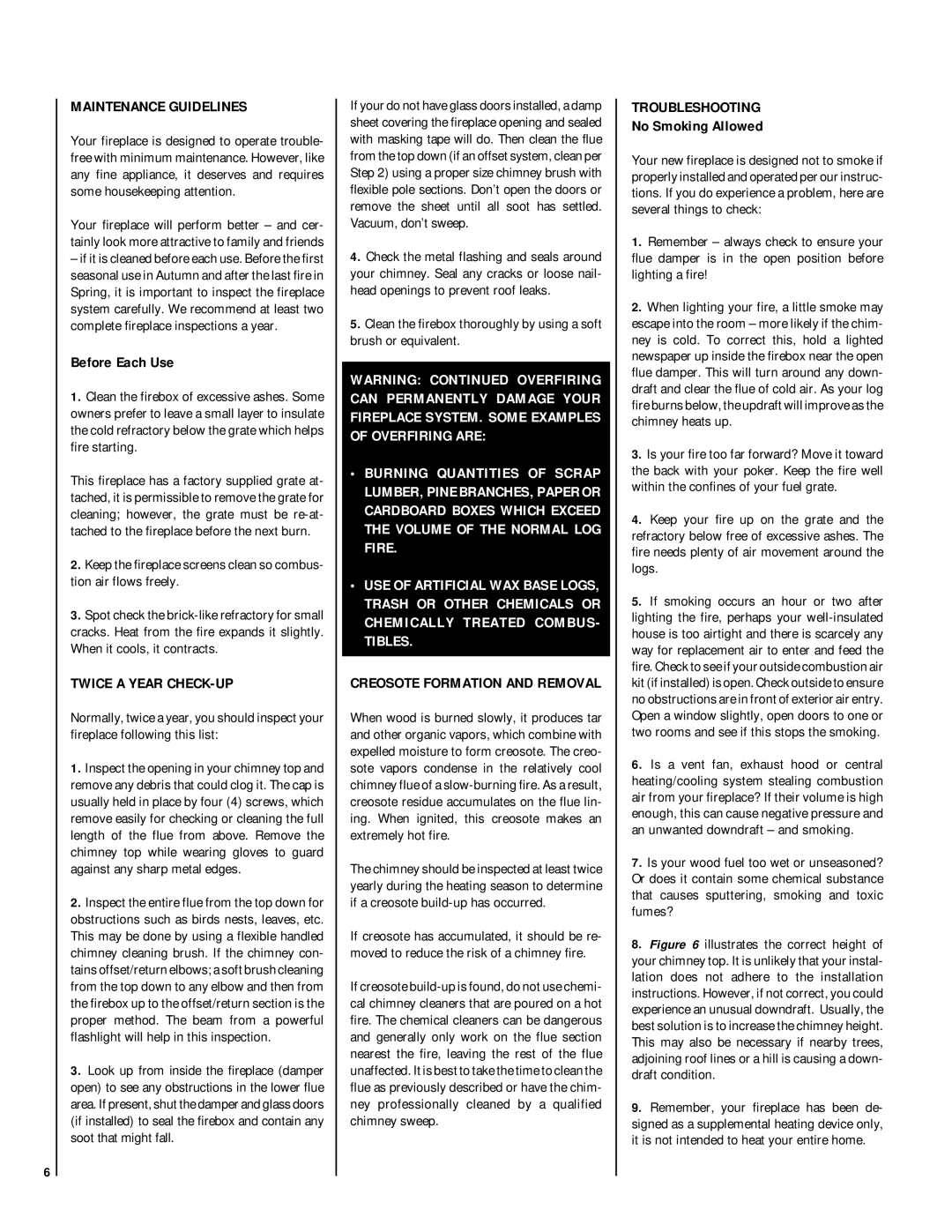
6
MAINTENANCE GUIDELINES
Your fireplace is designed to operate trouble- free with minimum maintenance. However, like any fine appliance, it deserves and requires some housekeeping attention.
Your fireplace will perform better – and cer- tainly look more attractive to family and friends
–if it is cleaned before each use. Before the first seasonal use in Autumn and after the last fire in Spring, it is important to inspect the fireplace system carefully. We recommend at least two complete fireplace inspections a year.
Before Each Use
1.Clean the firebox of excessive ashes. Some owners prefer to leave a small layer to insulate the cold refractory below the grate which helps fire starting.
This fireplace has a factory supplied grate at- tached, it is permissible to remove the grate for cleaning; however, the grate must be
2.Keep the fireplace screens clean so combus- tion air flows freely.
3.Spot check the
TWICE A YEAR CHECK-UP
Normally, twice a year, you should inspect your fireplace following this list:
1.Inspect the opening in your chimney top and remove any debris that could clog it. The cap is usually held in place by four (4) screws, which remove easily for checking or cleaning the full length of the flue from above. Remove the chimney top while wearing gloves to guard against any sharp metal edges.
2.Inspect the entire flue from the top down for obstructions such as birds nests, leaves, etc. This may be done by using a flexible handled chimney cleaning brush. If the chimney con- tains offset/return elbows; a soft brush cleaning from the top down to any elbow and then from the firebox up to the offset/return section is the proper method. The beam from a powerful flashlight will help in this inspection.
3.Look up from inside the fireplace (damper open) to see any obstructions in the lower flue area. If present, shut the damper and glass doors (if installed) to seal the firebox and contain any soot that might fall.
If your do not have glass doors installed, a damp sheet covering the fireplace opening and sealed with masking tape will do. Then clean the flue from the top down (if an offset system, clean per Step 2) using a proper size chimney brush with flexible pole sections. Don’t open the doors or remove the sheet until all soot has settled. Vacuum, don’t sweep.
4.Check the metal flashing and seals around your chimney. Seal any cracks or loose nail- head openings to prevent roof leaks.
5.Clean the firebox thoroughly by using a soft brush or equivalent.
WARNING: CONTINUED OVERFIRING CAN PERMANENTLY DAMAGE YOUR FIREPLACE SYSTEM. SOME EXAMPLES OF OVERFIRING ARE:
•BURNING QUANTITIES OF SCRAP LUMBER, PINE BRANCHES, PAPER OR CARDBOARD BOXES WHICH EXCEED THE VOLUME OF THE NORMAL LOG FIRE.
•USE OF ARTIFICIAL WAX BASE LOGS, TRASH OR OTHER CHEMICALS OR CHEMICALLY TREATED COMBUS- TIBLES.
CREOSOTE FORMATION AND REMOVAL
When wood is burned slowly, it produces tar and other organic vapors, which combine with expelled moisture to form creosote. The creo- sote vapors condense in the relatively cool chimney flue of a
The chimney should be inspected at least twice yearly during the heating season to determine if a creosote
If creosote has accumulated, it should be re- moved to reduce the risk of a chimney fire.
If creosote
TROUBLESHOOTING
No Smoking Allowed
Your new fireplace is designed not to smoke if properly installed and operated per our instruc- tions. If you do experience a problem, here are several things to check:
1.Remember – always check to ensure your flue damper is in the open position before lighting a fire!
2.When lighting your fire, a little smoke may escape into the room – more likely if the chim- ney is cold. To correct this, hold a lighted newspaper up inside the firebox near the open flue damper. This will turn around any down- draft and clear the flue of cold air. As your log fire burns below, the updraft will improve as the chimney heats up.
3.Is your fire too far forward? Move it toward the back with your poker. Keep the fire well within the confines of your fuel grate.
4.Keep your fire up on the grate and the refractory below free of excessive ashes. The fire needs plenty of air movement around the logs.
5.If smoking occurs an hour or two after lighting the fire, perhaps your
6.Is a vent fan, exhaust hood or central heating/cooling system stealing combustion air from your fireplace? If their volume is high enough, this can cause negative pressure and an unwanted downdraft – and smoking.
7.Is your wood fuel too wet or unseasoned? Or does it contain some chemical substance that causes sputtering, smoking and toxic fumes?
